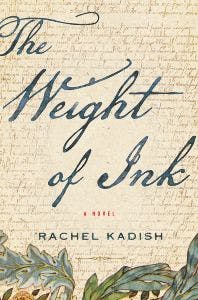The world is full of secret places. Behind a cupboard door, concealed by a secret panel, at the bottom of the sea—undiscovered treasures wait. Some are so damaged that they melt into dust at the slightest touch, while some are silt on the ocean floor. Many others became ash and smoke centuries ago. But some survive.
Every historian dreams of being the first to find a new cache of documents or a trove of artifacts. Discoveries like these change the topography of an academic field in an instant. The problem is that you cannot plan for them, and many of the most wonderful finds happen by accident. In 1940, some French teens and their dog chanced upon the Lascaux caves, which contain Paleolithic cave paintings approximately 15,000 to 17,000 years old. Seven years later, some teens (again) discovered the Dead Sea Scrolls in a Jericho cave while looking for a lost goat. A historian cannot compete with chance, in the hands of teenagers.

Rachel Kadish’s new novel The Weight of Ink follows in the tradition of these discovery stories. Kadish is also the author of the novels From a Sealed Room and Tolstoy Lied: a Love Story. The former was about an Israeli housewife, and the latter about a woman professor and her literary project on happiness. This new novel therefore represents a kind of synthesis of Kadish’s favorite themes.
The Weight of Ink follows most explicitly in the footsteps of A.S. Byatt’s Possession, combining a contemporary narrative about two historians with the contents of a cache of documents found under a staircase. Like Possession, Kadish’s novel follows a man and a woman—in this case, the postgraduate Aaron Levy and the elderly professor Helen Watt—as they grope in the dark of the past for a story that is just out of reach. Instead of a Victorian romance, however, Levy and Watt pursue the unknown author of the documents, which were written in 1660s London by a Portuguese Jew who formerly lived in Amsterdam.
In a great twist, that Jewish thinker of long ago turns out to have been a woman named Ester Velasquez. The question becomes: Whose inheritance are these documents? The Jewish community of the present day, represented by Aaron Levy, or women intellectuals of any faith, like the non-Jewish Helen Watt? In exploring that question, The Weight of Ink weighs religious doctrine’s relationship to the divine, the role of scholarship in Jewish identity, and the meaning of life in Israel.
In her 1988 book A Poetics of Postmodernism, Linda Hutcheon called novels like this “historiographic metafiction.” Such novels display a special awareness of the relationship between history and literature. They happily exploit real events and lives from the past, unconcerned with to-the-letter accuracy. Kadish uses the plague and the Great Fire of London just as Leonardo Padura used Rembrandt in his recent book Heretics and E. L. Doctorow used Harry Houdini and Booker T. Washington in Ragtime. But in re-writing those real events, embedding a creative vision of the past in a contemporary fiction, novelists reveal how history is continually imbricated into the texture of our world. The past is not a conclusive “backstory” to our lives, but a powerful resource that opens out into every narrative, every fiction, every self.
Historiographic metafiction is an intrinsically postmodern form, by Hutcheon’s definition, and so it follows that these books have special pertinence to the moment of their writing. Extraordinarily, The Weight of Ink is the second major novel of 2017 to explore seventeenth-century Jewish culture in Amsterdam. Padura’s Heretics also dwells there, although his focus is on a Jewish assistant to Rembrandt, forbidden to make representative art by his religion.
Both novels touch on the crisis caused by Sabbatai Zevi, a seventeenth-century rabbi in the Ottoman Empire, claiming to be the Jewish Messiah. They both address the herem—or shunning—of the philosopher Baruch Spinoza at the age of 23, as well as the significance of the return of Jews to England.
Spinoza’s heresy over the nature of God—and what it meant for the Jewish community, then and now—is the symbolic core of The Weight of Ink, connecting the thinker behind the book’s trove of documents to the present-day characters studying them. In Heretics, Spinoza also served as the paradigmatic recipient of excommunication, an example of the terrible fate of those who run afoul of dogma. Other recent fiction on the subject includes Irvin Yalom’s 2012 The Spinoza Problem, which connected Spinoza’s life to the Nazi philosopher Alfred Rosenberg.
Why Spinoza, now? He is a strange figure to pick from history, precisely because he barely seems to represent his times. Spinoza’s thought was so radical and his life so strange that he feels anomalous. When a novelist embraces history in a creative way, but picks somebody as “ahistorical” as Spinoza, what are they saying about the relationship between the past and the present? At least in Kadish and Padura’s case, they seem to use Spinoza to say: All that matters is the individual, all that matters is the life, all that matters is the story.
The Weight of Ink is a deeply moving novel, although it is hobbled at the end by a corny revelation about who Ester Velasquez really is. This final move is unnecessary and it undermines the principle that the life is all that matters; it makes Ester subservient to an older vision of history. But then again, Possession is a little corny too. Digging pretty stories about love out of the past may be a postmodern thing to do, but it’s also an easy way to tug at the heartstrings. It’s watching the past like a movie; it’s history as The English Patient.
But if Spinoza is the new golden boy of this tricky form, then sentimentality can never define it, because it will have something absurdly complex at its thematic core. In his own words, “All things excellent are as difficult as they are rare.”
